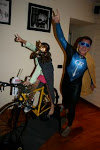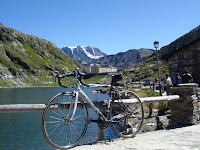Ciao Zio Tony Fans! Welcome back to the "Great Teteuns!" weekend in Val d' Aosta and the closing chapter of my journey to discover the unusual. However, as you are about to experience, when I finally arrived at the "signature destination" of my travels, I was overwhelmed with the notion that the more we explore the unfamiliar, the more we discover the familiar. Granted, Italian culture is not so different than our own to find the similarities incredulous. But, that’s really not the point.
It’s just that when coming across a epicurean specialty called “teteun”, described simply as “cow’s udder, to which Gignod dedicates a festival”, one’s expectations are naturally set for something out of the ordinary.
 Gignod is in the northwest Italian province of Val ‘d Aosta, not in Kansas, so; the setting is not what we’d expect for a Midwestern county fair.
Gignod is in the northwest Italian province of Val ‘d Aosta, not in Kansas, so; the setting is not what we’d expect for a Midwestern county fair.
But, it turns out the closer you get, the more things start looking familiar ...
 Women gossip on benches while their husbands huddle together at the bar ...
Women gossip on benches while their husbands huddle together at the bar ...
and, of course, children want to be children anywhere ...

Which may not be so unusually usual. But, if you recall my first blog post, “Ciao Cowboy”,

... and realize that the name Gran Teton (the mountain range you see in the background) shares a mammarial association with the word “teteun”, you’ll understand why I almost fell over at what I saw sauntering by ...

The dance hall was also pleasantly familiar. Actually, the only thing out of the ordinary was how these people could dance straight up & down a wall. (By the way, on a completely unrelated subject, if anybody knows how to rotate movie video, please drop ole' Uncle T a tip ). Otherwise, having spent a few years two-stepping in Texas, I easily recognized the familiar ways of the different couples: the marchers, the shufflers, the spinners, the gliders, and the two old ladies dancing together ...
Getting to the "fait accompli" of the Feta di Tetuen was no different. Standing in line at the chow hall and eves dropping on the conversations (the best I could, as my Italian still has a long way to go and the local dialect seems to be smattered with French), I found myself in the middle of a Rotary Club or Boy Scout dinner.


Except, the wine selection was much better and served only by the bottle (in this case, a plummy young "Gamay")


Granted, what you see on the plate may not stimulate a dyed in the wool vegetarian - but, I imagine it packs enough of a Pavlovian ping to trickle the salivary glands of other omnivores out there. (By the way, the "teteun" is the organ looking piece of meat in between the chops & the sausages ... :)P
In the end, it seems that one of the many joys of traveling and exploring something new, is the comforting re-discovery of where we have already been. So, I'm glad to report that the only unusual thing I discovered at the Feta di Teteun is that cow's udder is a meat that .... well ... tastes like cheese.




































.jpg)



























